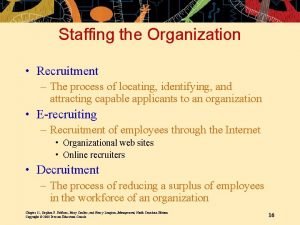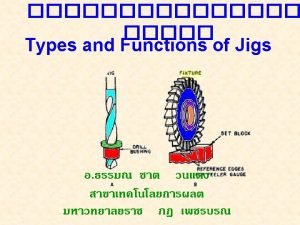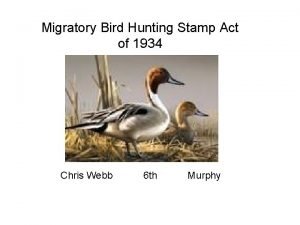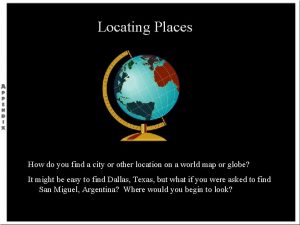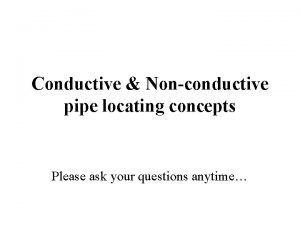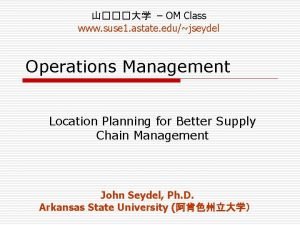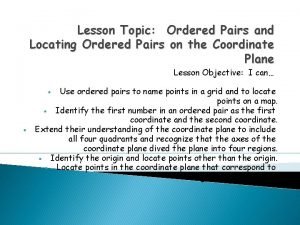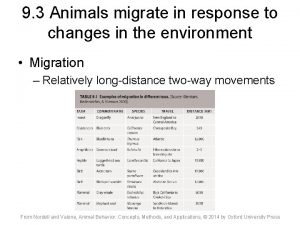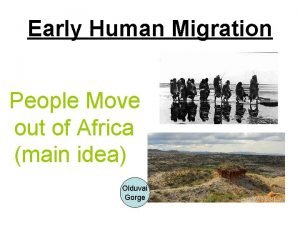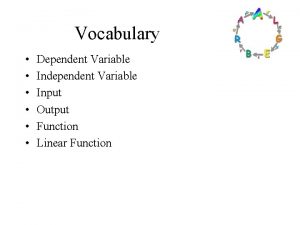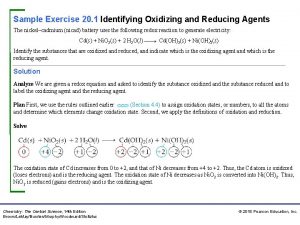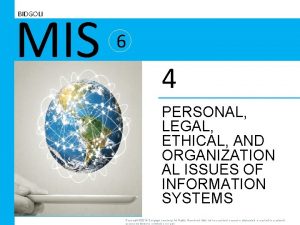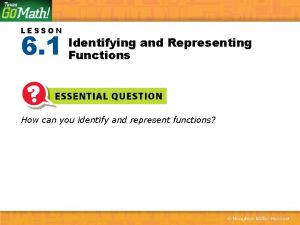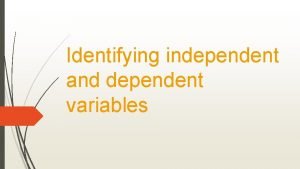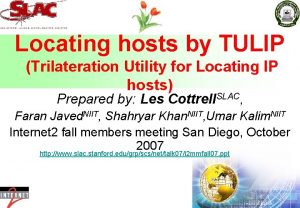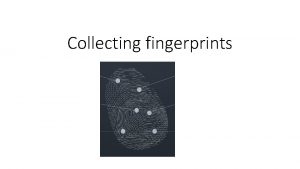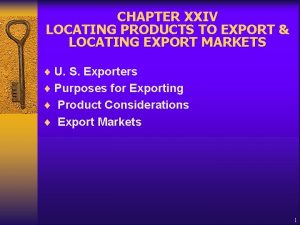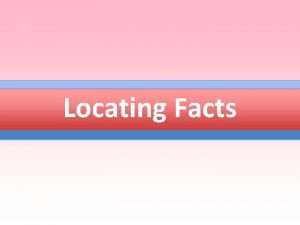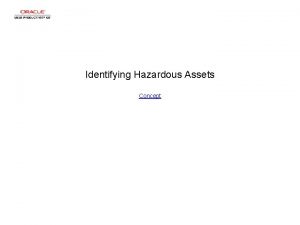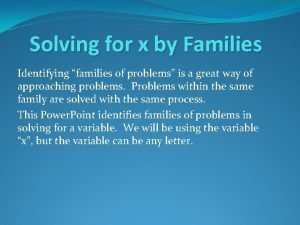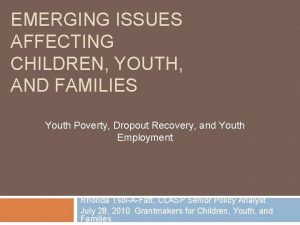Identifying Migratory Families Locating Migratory Families and Youth






































- Slides: 38

Identifying Migratory Families Locating Migratory Families and Youth National ID&R Curriculum, Module 4 Level 1

Materials • Module 4 Level 1 Outline • Handouts, as needed • Pen or pencil • Highlighters • Post-its® 2

Level 1: Goal The participant will know how to determine where migratory families and youth live and work. 3

Level 1: Objectives Participants will be able to • use appropriate vocabulary when discussing qualifying moves for qualifying work; • describe the types of qualifying seasonal and temporary employment that migratory families seek; and • identify key areas where migratory families and youth live and work. 4

Level 1: Agenda • What’s Missing? • Qualifying Moves • Types of Qualifying Work • Locating Migratory Families and Youth • Assessment • One Thing, Just One Thing 5

What’s Missing? Word Bank 1. Agricultural work 2. Fishing work 3. Home base 4. Migratory streams 5. Out-of-school youth 6. Send and receive 7. Settled out 8. Migratory child 9. Migratory agricultural worker 10. Qualifying move 6

What’s Missing? 1. _______ a child who made a qualifying move in the preceding 36 months as a migratory agricultural worker or a migratory fisher or did so with, or to join, a parent/guardian or spouse who is a migratory agricultural worker or migratory fisher. 7

What’s Missing? 2. _______ are under the age of 22, have dropped out of school, and may be working on an HSED outside of a K– 12 institution, or may be “here to work” only. 8

What’s Missing? 3. _______ is a person who, in the preceding 36 months, made a qualifying move and, after doing so, engaged in new temporary or seasonal employment or personal subsistence in agriculture. 9

What’s Missing? 4. A _______ is • made due to economic necessity; • from one residence to another residence; and • from one school district to another school district. 10

What’s Missing? 5. A town, city, or state may _________ migratory workers. South Carolina: receiving state Florida: sending state 11

What’s Missing? 6. Migratory workers were believed to follow one of three distinct patterns of migration, commonly known as __________. 12

What’s Missing? Traditional Migratory Streams West Coast Stream Eastern Stream Mid-Continent Stream 13

What’s Missing? 7. When a migratory family has _____, or stopped migrating and becomes permanently established in an area, it may become more involved in a community. 14

What’s Missing? 8. _______ means the production or initial processing of crops, dairy products, poultry, or livestock, as well as the cultivation or harvesting of trees, that is performed for wages or personal subsistence. 15

What’s Missing? 9. _______ refers to the catching or initial processing of fish or shellfish, as well as the raising or harvesting of fish or shellfish at fish farms, that is performed for wages or personal subsistence. 16

What’s Missing? 10. Complete the graphic organizer. 17

What’s Missing? 11. Complete the graphic organizer. 18

Migratory Streams — Traditional 19

Migratory Streams — Current 20

Types of Qualifying Work Temporary Seasonal Repairing a fence Trapping lobsters Feeding cattle Planting potatoes Debeaking chickens Cultivating corn Slaughtering pigs Thinning sugar beets Milking cows Detasseling corn Packaging shrimp Planting seeds for hay Canning tomatoes 21

Temporary Employment • Defined as employment that lasts for a limited period of time, usually a few months, but no longer than 12 months • Determined in one of three ways: o Employer Statement o Worker Statement o State Determination 22

Temporary Employment • Employer Statement – The employer states that the worker was hired for a limited time frame, not to exceed 12 months • Worker Statement – The worker states that he or she does not intend to remain in that employment indefinitely (i. e. , the worker’s employment will not last longer than 12 months) • State Determination – The SEA has determined on some other reasonable basis that the employment will not last longer than 12 months 23

Seasonal or Temporary? • Get one index card person. • Write “seasonal” on one side; “temporary” on the other. • Talk with your partner. • Show your card when asked. 24

Seasonal or Temporary? seasonal clearing land to plant sorghum 25

Seasonal or Temporary? seasonal drying herbs 26

Seasonal or Temporary? temporary sizing shrimp 27

Seasonal or Temporary? temporary building a barn 28

Seasonal or Temporary? temporary cutting meat 29

Seasonal or Temporary? seasonal picking peaches 30

Locating Migratory Families and Youth • Start at your assigned question. • Record as many responses as possible. • Move to the next question when signaled. 31

Locating Migratory Families and Youth Where might you find migratory families and youth? 32

Locating Migratory Families and Youth Out-of-School Youth (OSY) • Unique needs • Worksite recruitment 33

Locating Migratory Families and Youth How would you communicate information about the MEP at these locations? 34

Locating Migratory Families and Youth Why is it difficult for recruiters to locate migratory families and youth? 35

Wrap-Up “To find local migratory farm workers, I follow the port-ajohn trucks to the fields and post flyers about the program on the inside of the doors. ” 36

Level 1: Assessment • Please complete the assessment independently. • When all participants are done, discuss answers with a partner; revise answers if needed. • We will review as a whole group and you will grade your own. 37

One Thing, Just One Thing • Think about everything we learned today. • What’s the one main point you would like other MEP recruiters to know? 38
 Recruitment is the process of locating identifying and
Recruitment is the process of locating identifying and Identifying and non identifying adjective clauses
Identifying and non identifying adjective clauses Whats an adjective clause
Whats an adjective clause Information essential
Information essential Angle plate jig diagram
Angle plate jig diagram Locating tetrahedral and octahedral voids
Locating tetrahedral and octahedral voids Big families vs small families
Big families vs small families Migratory bird hunting stamp act
Migratory bird hunting stamp act Locating places
Locating places Rules in the selection of delta
Rules in the selection of delta Non conductive pipe
Non conductive pipe Earth science regents lab practical
Earth science regents lab practical Four ways of locating the ethical in you
Four ways of locating the ethical in you Champion cooling company is locating a warehouse
Champion cooling company is locating a warehouse Triangulation of epicenter
Triangulation of epicenter Smart city locating
Smart city locating Directly stated examples
Directly stated examples Locating ordered pairs on the coordinate plane
Locating ordered pairs on the coordinate plane Migratory aptitude is greater for
Migratory aptitude is greater for Migratory behavior
Migratory behavior Migratory aptitude is greater for
Migratory aptitude is greater for Early human migration map
Early human migration map Ttl and cmos logic families and their characteristics
Ttl and cmos logic families and their characteristics Compare and contrast the bach and marsalis families
Compare and contrast the bach and marsalis families Compare and contrast the bach and marsalis families
Compare and contrast the bach and marsalis families Marriages and families 8th edition
Marriages and families 8th edition Marriages and families changes choices and constraints
Marriages and families changes choices and constraints What is dependent and independent variable
What is dependent and independent variable Style and tone examples
Style and tone examples Tone and style examples
Tone and style examples Identifying oxidizing and reducing agents
Identifying oxidizing and reducing agents Faulty parallel structure
Faulty parallel structure Mis bidgoli
Mis bidgoli Lesson 6.1 representing functions answer key
Lesson 6.1 representing functions answer key Identifying the inquiry and stating the problem
Identifying the inquiry and stating the problem What is a dependent variable in math
What is a dependent variable in math Identifying and correcting sentence fragments
Identifying and correcting sentence fragments Kikin el vikinguin
Kikin el vikinguin Identifying market segments and targets chapter 9
Identifying market segments and targets chapter 9
